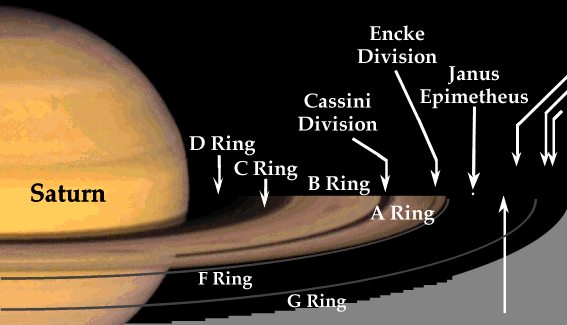

The figure shows the very tenuous E Ring (outer gray zone),
then the G and F Rings (thin lines, black in front of the planet)
before the bright A Ring (with Encke's Division),
then Cassini's Division and the bright B Ring.
Nearer to the planet are the dark C Ring and the tenuous D Ring, only visible in front of the planet.
The rings were named in the order of their discoveries.
The arrows indicate (from the furthest) the approaches of Pioneer 11 (2,92 Rs), Voyager 2 (2,88 Rs), Pioneer 11 (closest, 2.78 Rs), and the distance of Saturn Orbital Insertion (SOI) of the Cassini orbiter in July 1 2004, between the F and G Rings, at some 158,500 Km (2.63 Rs). Then the orbital radius of the satellites Janus and Epimetheus (~151,450 Km).
Rs (Radius of Saturn) = 60,330 Km.
The E Ring reaches from ~180,000 Km out to ~480,000 Km of the center of Saturn.
The G Ring is ~170,000 Km of the center of Saturn.
The F Ring is 140,219 Km of the center of Saturn.
The A Ring reaches out to 136,780 Km of the center of Saturn.
Encke's Division extends from 133,410 Km to 133,740 Km of the center of Saturn.
Cassini's Division reaches out to 122,340 Km of the center of Saturn.
The B Ring reaches out to 117,507 Km of the center of Saturn.
The C Ring reaches out to 91,975 Km of the center of Saturn.
The D Ring reaches out to 74,658 Km of the center of Saturn.
The D Ring starts ~66,900 Km of the center of Saturn.
Pioneer 11 approached to 21,000 Km of Saturn's highest clouds on September 1, 1979.
Voyager 1 approached to 3.09 Rs of Saturn on November 12, 1980.
Voyager 2 approached to 2.67 Rs of Saturn on August of 1981.
Original information from
Saturn's Ring System
The Planetary Rings Node at NASA Planetary Data System (PDS)
For the most recent information on Saturn, see
Cassini-Huygens Mission and
Cassini-Huygens Close Encounter with Saturn
(NASA-ESA)
![]() Updated: July 4 '04
Updated: July 4 '04
Best seen with Netscape Navigator and MS Internet Explorer.
Back: ARVAL - Image Gallery
Messages: